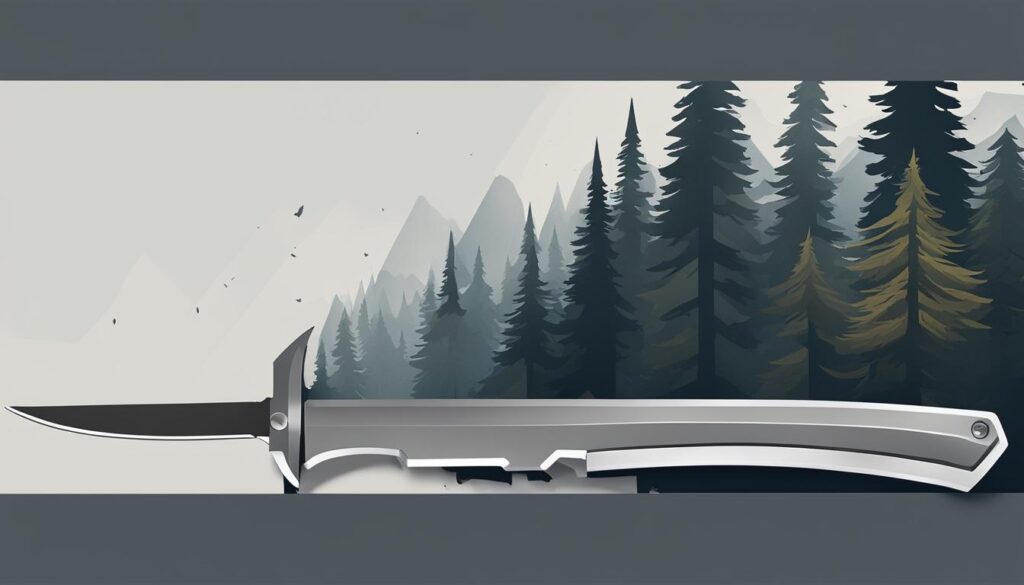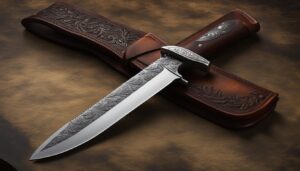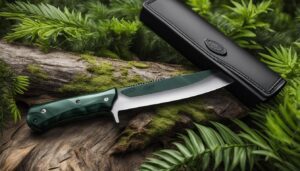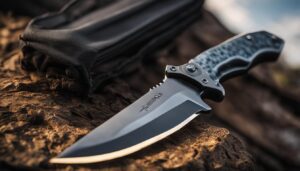Achieving optimal knife balance is the key to a successful hunting experience. The balance of a knife plays a crucial role in its performance, ensuring it is strong, easy to handle, and suitable for various hunting tasks. From the tang to the blade type, every element contributes to achieving the perfect balance.
When it comes to balanced knife design, factors such as handle material, blade length, and weight distribution all come into play. By understanding how these elements affect knife balance, hunters can choose the right knife for their specific needs and preferences.
In this article, I will delve into the various factors that contribute to optimal knife balance. From the importance of tang and handle material to choosing the right metal and blade type, we will explore the nuances of achieving the perfect balance for your hunting adventures.
Key Takeaways:
- Optimal knife balance is essential for a successful hunting experience.
- Factors such as tang, handle material, blade type, and weight distribution contribute to achieving the perfect balance.
- Full-tang blades and polymer handles offer better grip and durability.
- Stainless steel is the preferred choice for hunting knives due to its rust resistance.
- The blade length and thickness should be balanced and comfortable for precise movements.
The Importance of Tang and Handle Material
When it comes to achieving optimal knife balance for your hunting experience, the tang and handle material play a crucial role. The tang refers to the portion of the blade that extends into the handle, and a full-tang blade is highly recommended for a strong and durable deer knife. A full-tang blade provides stability and ensures that the knife can handle heavy-duty tasks such as splitting the pelvis of an elk. It also enhances the overall strength and balance of the knife, making it easier to control during intricate maneuvers.
Another essential factor to consider is the handle material. Different handle materials offer unique advantages and considerations. For hunters who value elegance and a comfortable grip, bone handles are an excellent choice. Bone handles not only provide a secure hold but also add a touch of traditional craftsmanship to the knife. However, it is essential to note that wood handles can become slippery, especially when covered in blood. In contrast, polymer handles, such as those made of hard rubber, offer superior grip even when exposed to blood. This makes them safer for hunters as they provide enhanced control in various weather conditions and hunting environments.
When selecting a hunting knife, it is crucial to prioritize a full-tang blade design for strength and durability, while considering the advantages and disadvantages of different handle materials. The combination of a full-tang blade and the right handle material will contribute to the overall balance and performance of your knife, ensuring a successful hunting experience.
Comparison of Handle Materials
| Handle Material | Advantages | Considerations |
|---|---|---|
| Bone | Elegant, comfortable grip | Can be slippery in blood |
| Wood | Natural aesthetic | Can become slippery |
| Polymer (Hard Rubber) | Excellent grip, even in blood | May lack traditional appeal |
Choosing the Right Metal and Blade Type
When it comes to selecting a hunting knife, one crucial consideration is the type of metal used for the blade. Two common options are carbon steel and stainless steel. Each metal has its advantages and disadvantages, and understanding these differences will help you make an informed decision.
Carbon steel blades are known for their exceptional sharpness and ability to hold an edge. They are relatively easy to sharpen, making them a popular choice for hunters who prioritize razor-like cutting performance. However, carbon steel blades are more prone to rust and corrosion, requiring regular maintenance and care.
Stainless steel blades, on the other hand, offer superior resistance to rust and corrosion, making them ideal for use in wet or humid hunting conditions. While they may not hold an edge as well as carbon steel, stainless steel blades require less maintenance and offer better longevity. Whether you prioritize sharpness or rust resistance, the choice between carbon steel and stainless steel ultimately comes down to your individual needs and preferences.

Blade Type and Point
Another important aspect to consider when choosing a hunting knife is the blade type and point. The blade type refers to the overall shape and design, while the point refers to the shape of the tip. Different blade types and points offer unique advantages for specific hunting tasks.
A common blade type for hunting knives is the drop point. This blade shape features a curved edge and a well-defined point, making it versatile for both skinning and slicing meat. The drop point blade allows for precise control and reduces the risk of puncturing internal organs while dressing game.
Other blade types, such as the clip point or the trailing point, have their own benefits and uses. The clip point, with its concave curve near the tip, offers enhanced piercing capability, making it suitable for detailed and delicate cutting tasks. The trailing point blade, with its upward curve, provides an extended cutting surface, making it efficient for slicing through larger portions of meat.
Table: Comparison of Blade Types
| Blade Type | Advantages |
|---|---|
| Drop Point | Versatile for skinning and slicing, reduces the risk of puncturing organs |
| Clip Point | Enhanced piercing capability, suitable for detailed cutting tasks |
| Trailing Point | Extended cutting surface, efficient for slicing larger portions of meat |
Choosing the right blade type and point depends on the specific hunting tasks you expect to encounter. Consider the balance between versatility, precision, and slicing efficiency to find the blade that best suits your needs.
Finding the Right Blade Dimensions
When choosing a deer knife, it’s important to consider the blade dimensions to ensure optimal performance. The blade length and thickness play a significant role in the knife’s versatility and suitability for various hunting tasks. Finding the right balance between blade length and thickness is essential to ensure a comfortable grip and precise movements during field-dressing, skinning, and butchering.
In terms of blade length, a range of 3 to 5 inches is generally suitable for a deer knife. A longer blade provides more reach and is ideal for tasks such as reaching into a chest cavity or caping a buck. On the other hand, a shorter blade offers better maneuverability and control for intricate tasks like skinning. Consider your specific hunting needs and preferences when selecting the appropriate blade length.
As for blade thickness, it’s recommended to aim for a range of .12 to .14 of an inch. This range provides a good balance between strength and weight. A blade that is too thick may be heavy and cumbersome, while a blade that is too thin may lack durability and stability. The ideal thickness ensures that the knife can handle tough tasks while remaining lightweight and easy to handle.
Ultimately, the right blade dimensions will depend on personal preference and the specific hunting tasks you will be performing. Consider the balance between blade length and thickness to find a knife that feels comfortable and performs optimally for your hunting needs.


Table: Blade Dimensions Comparison
| Blade Length (in inches) | Blade Thickness (in inches) |
|---|---|
| 3 | .12 |
| 4 | .13 |
| 5 | .14 |
Benefits and Drawbacks of Guthooks and Folding Knives
When it comes to hunting knives, there are different options to consider, including guthooks and folding knives. Both have their unique benefits and drawbacks, and the choice between the two ultimately depends on personal preference and hunting style.
Guthooks are specialized blades that feature a small hook on the spine of the blade near the tip. They are designed to assist with field-dressing game by easily unzipping the abdomen without damaging internal organs. This can be particularly useful for hunters who prefer to gut their game in the field. However, guthooks can be challenging to keep sharp and require specialized sharpening tools. If not properly maintained, the hook can become dull or damaged, diminishing its effectiveness.
On the other hand, folding knives offer convenience and versatility. They are compact, easy to carry, and can be safely folded for storage. The popular Buck Model 110, for example, is known for its folding design and has been a favorite among hunters for decades. Folding knives are available in various blade styles, including drop point, clip point, and tanto, providing hunters with options to suit their specific needs. However, it’s important to note that folding knives may not offer the same level of strength and reliability as sheath knives with a full-tang design.
Sheath knives, particularly those with a full-tang design, are favored by many hunters for their robustness and dependability. A full-tang blade extends the full length of the knife, from the blade tip to the handle, providing excellent strength and stability. Sheath knives are typically carried in a sheath on the belt, allowing for quick and easy access when needed. While sheath knives may be bulkier and require more storage space, they offer the reassurance of a strong and reliable tool.
| Guthooks | Folding Knives |
|---|---|
| Guthooks assist with unzipping the abdomen during field-dressing. | Folding knives offer convenience and portability. |
| Can be challenging to maintain and sharpen. | Come in various blade styles to suit different needs. |
| Specialized sharpening tools may be required. | May not offer the same level of strength as full-tang sheath knives. |
In conclusion, the choice between guthooks and folding knives boils down to personal preference and the specific requirements of the hunting situation. Guthooks can be advantageous for field-dressing, but they require proper maintenance and sharpening. Folding knives offer convenience and versatility, but may not provide the same level of strength as sheath knives. Ultimately, hunters should consider their own preferences and needs to select the knife that best suits their hunting style and requirements.
Conclusion
Achieving the perfect knife balance is the key to a successful hunting experience. Throughout this article, we have explored the various factors that contribute to this balance, including the tang, handle material, blade type, blade point, blade length, and blade thickness.
By carefully considering these aspects, hunters can find the ideal blade balance that suits their needs and preferences. The right knife should feel comfortable and balanced in your hand, allowing for precise movements and control during tasks such as field-dressing, skinning, and butchering.
Remember, the goal is to find the sweet spot where the knife is strong, easy to handle, and suitable for various hunting tasks. By achieving optimal knife balance, you can enhance your hunting skills and make the most out of your hunting experience.
FAQ
Why is knife balance important for hunting?
Achieving optimal knife balance is essential for a successful hunting experience. The balance of a knife affects its strength, maneuverability, and suitability for various hunting tasks.
What factors determine the balance of a knife?
The balance of a knife is determined by factors such as the tang, handle material, blade type, blade point, blade length, blade thickness, and the presence of a guthook.
What is a full-tang blade?
A full-tang blade is one that extends the full length of the handle, providing strength and durability, particularly for heavy-duty tasks.
What are the benefits of bone handles?
Bone handles are elegant and provide a comfortable grip.
Are wood handles suitable for hunting knives?
Wood handles can be slippery when covered in blood, making them less suitable for hunting knives.
What are the advantages of polymer handles?
Polymer handles, such as those made of hard rubber, offer better grip even when they are bloody, making them safer for hunters.
What is the preferred choice of blade metal for hunting knives?
Stainless steel is the preferred choice for hunting knives due to its resistance to rust.
What are the advantages of carbon steel knives?
Carbon steel knives are easier to sharpen but require more frequent sharpening.
What type of blade is suitable for deer hunting?
The blade type of a deer knife should be designed for cutting rather than stabbing, with a single sharpened edge and a slight curve for versatility in both skinning and slicing meat.
What is the best blade shape for skinning?
The drop-point blade shape is considered the best for skinning as it allows for quick and precise skinning without damaging the meat.
What is the optimal blade length for a deer knife?
Generally, a blade length in the range of 3 to 5 inches is suitable for an ultimate deer knife.
What is the recommended blade thickness for a deer knife?
The blade thickness should be around .12 to .14 of an inch, providing the perfect balance between strength and weight.
Are guthooks necessary for a deer knife?
Guthooks can be useful for unzipping a deer’s abdomen without damaging internal organs, but they can be challenging to keep sharp and require specialized sharpening tools.
What are the benefits of folding knives?
Folding knives offer convenience and versatility.
Why are sheath knives with a full-tang design preferred by many hunters?
Sheath knives with a full-tang design are preferred by many hunters for their strength and reliability.
How can I achieve optimal knife balance for my hunting needs?
By considering factors such as tang, handle material, blade type, blade point, blade length, and blade thickness, hunters can find the ideal blade balance that suits their needs and preferences.





